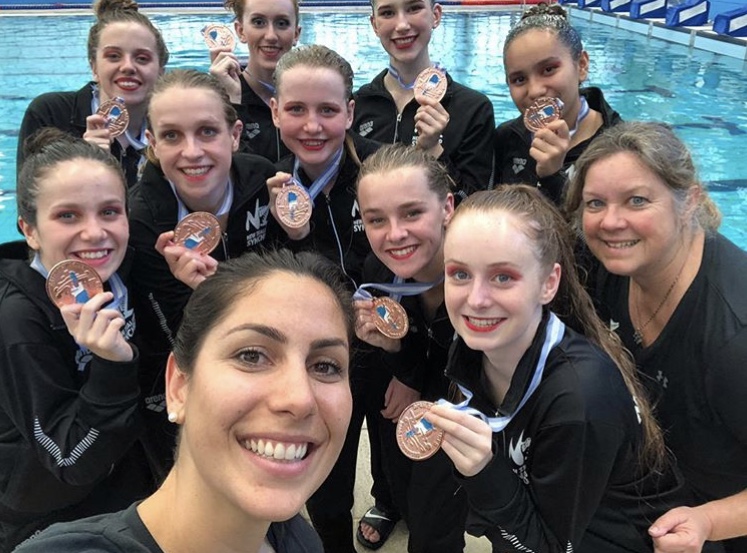Before heading to South America to compete internationally, we sat down with the coaching team of our national synchronised swimming squads, the AquaFerns and Koru.
With sparkly smiles, frilly caps and nose clips, synchronised swimming can look like a gentle, low-intensity activity. But take a look under the water and you’ll see a unique combination of swimming, power, speed and grace, and the occasional kick in the shins. “Everyone thinks it’s easy because we’re smiling and being graceful, but it’s a lot of hard work,” says AquaFerns coach Lara Teixeira Cianciarulo. “We egg-beat, kick each other under the water, we throw people, we hold our breaths. It’s three and a half minutes of really high heart rates.”
AUT Millennium hosted the New Zealand AquaFerns and Koru squads for training camps in the back half of 2018, as the squad worked towards two international competitions in late November and early December. Lara, a three-time Olympian, and Assistant Coach Deidre Harrison, have selected a squad of young swimmers from around the country. Due to small numbers within the sport, the junior Koru squad also make up the senior AquaFerns squad, with the addition of only one member who is ineligible at junior level. “We combine the squads to have enough to compete at international competitions,” says Deidre. “At both the Argentina Opens and Brazil Opens, the Koru squad will compete as a team, then we will add in Eva (Morris), and compete as a senior squad.”
While the sport has funded small campaigns for synchro duets in the past, this group will be the first to benefit from a dedicated, long-term team campaign. “Last year we took the Piko Piko squad to Malaysia, as 13-15 year olds,” Deidre says. “Now those girls have all moved up into the Koru squad, and we’re able to keep working with them towards Junior Championships in 2020. After that event, we’ll reassess and set new targets.”
Lara knows from experience that long term investment pays dividends. Having competed for Brazil at the Beijing, London and Rio Olympics, she is in the position to motivate the girls with stories of what awaits them on the grandest stage. “I tell them that you have to commit long term if you want your dream to come true,” she says. “My biggest hope is to have an Olympics squad in Paris in 2024,” she says. “I’ve seen big growth in the two years I’ve been in the country. This group in particular have a strong bond, and they’re invested and driven. If the girls stay together, I’m excited about the future.”

How synchro works
Synchronised swimming does not get a lot of coverage in New Zealand, so the unfamiliarity with the sport can make it difficult to see through the stereotypes. The intricate technical elements of the sport are generally hidden beneath the water, so to the untrained eye, it can be difficult to follow.
At the competitive level, there are four events – solos, duets, team (eight swimmers) and free combination (ten swimmers). The Koru and AquaFerns squad are in the team category, which requires them to perfect both a technical and free routine. 70% of the technical routine score is based on six compulsory elements which need to be performed in a prescribed order and in different orientations. In the free routine, the team can showcase more creativity, the only restriction being a limit on lifts. There are three separate judging panels critiquing either difficulty, execution or artistic elements. “Each of those aspects are weighted differently,” tells Deidre. “They’re looking at your interpretation of the music, the pool pattern, and the strength of travelling in the water.” Technical points are awarded for vertical alignment, twists and transitions between movements. Swimmers are penalised if they touch the bottom of the pool.
To accurately perform these difficult movements, some upside down under the water, synchro athletes must be extremely well-conditioned. Many of the national squad are in the water at least four days a week, with long training sessions on the weekends. They are prescribed fitness plans to follow, focusing on core strength, swimming and flexibility. “We need all shapes and sizes in the team,” Lara says. “In our squad, the smaller girls are at the top of the lifts, while the stronger ones are at the bottom, they’re the power athletes. We’re not in the position to pick and choose our athletes, so we’re happy to develop their speed, power and strength.”
During camps, the squad spend time focusing on other high performance aspects which aren’t provided at club level. “We try to bring in psychologists and nutritionists to really help with their mindset and performance,” says Lara. “While we’re honing the routine, we’re also focusing more on what you need to do to perform at the highest level.” Their time at AUT Millennium added to this inspiration, after brushing shoulders with some of our country’s leading Olympians. “The girls were so excited to be in the same environment as these athletes,” Lara recalls. “You could see them thinking ‘That could be us!’ It’s important for the girls to see that high performance athletes give 100% in their training as well as their performance.”
Synchro struggles
Like many smaller sports, the biggest hurdle for synchro is funding. The national body receives a minimal amount of funding, which leaves clubs and families doing the hard yards with sausage sizzles and movie nights. It’s a world away from Lara’s experience in Brazil, where synchro sport was funded by the government. “It’s a little bit frustrating,” she admits. “We see girls who are very talented and committed, but are unable to manage financially. It’s our job to focus on this squad, and grow the sport, then look into sponsorship to help our athletes.”
For now, the experience of competing internationally, away from home comforts, under pressure from senior standard judging panels, is a learning opportunity for the squad. “This group is really young,” Lara says. “We are aiming to show them what it is like competing at this level, and hopefully improve our ranking. We want to show the synchro world that New Zealand is invested.”
To find out more about synchronised swimming, including club details, visit www.sporty.co.nz/synchronz/Home






































